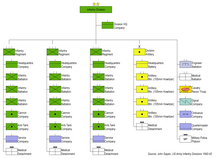Square division
A square division is a designation given to the way military divisions are organized. In a square organization, the division's main body is composed of four "maneuver," i.e., infantry regimental elements. Other types of regiments, such as artillery, are not "maneuver" units and thus are not considered in the "square," viz, "four" (infantry) regiments scheme. The usual grouping within a division would be to have two infantry regiments grouped together as an infantry brigade. (A U.S. infantry regiment consisted of three infantry battalions.) On an organizational chart, and if the entire division were formed up in the field, the two infantry brigades of two infantry regiments each (plus a machine gun battalion and a regimental headquarters and headquarters company in each regiment) would typically form a square, hence the name. Again, other "supporting" regiments (and their parent brigades, such as a divisional artillery brigade as found in U.S. Army divisions from circa 1917 until circa 1940) are not considered in this "square" division organization plan.
Most European divisions were organized as square divisions prior to World War I. They were generally reorganized as triangular divisions during that war. A triangular division generally had its infantry organized into three infantry regiments (again, containing three infantry battalions) either directly controlled by the division headquarters or under a single brigade command. Thus, the designation "triangular" because only the infantry regiments (with no brigades) were considered. Once again, artillery, and other types of regiments, were not considered in the term "triangular" division. For example, the organizational changes of the Imperial German Army's 1st Division. Triangular divisions were smaller, allowing for more divisions to be formed, and were considered more suited for the positional warfare which characterized World War I.
A square division typically advanced with two infantry brigades in line or with the brigades echeloned (one ahead of the other), with one infantry regiment forward and one in reserve ready to engage when the first regiment came into contact with the enemy. In contrast, the triangular division normally employed a "two up, one back" arrangement for its three infantry regiments. In positional warfare, the infantry regiments were formed in line to cover as much of a sector as possible with their three infantry battalions usually positioned with two battalions forward and one battalion positioned behind them to provide "defense in depth." An infantry regimental commander would typically hold a reinforced rifle company or two (and rarely an entire battalion) from one of his three infantry battalions, with supporting arms, in the "rear" as the "regimental reserve." Similarly, infantry battalion commanders would typically hold a reinforced rifle platoon (and sometimes an entire rifle company) from one of his battalion's rifle companies, with supporting crew-served weapons, as the "battalion reserve."


United States[]
During World War I, the United States Army formed its divisions as square divisions, in contrast to the prevailing European norm.[1] The United States had the manpower to form the divisions, and expected to be engaging in more offensive operations as the trench warfare stalemate, which consumed so much of the war on the Western Front, was broken late in the war.[2] U.S. Army divisions remained organized as square divisions after the war and up to World War II. In 1940 through early 1942, during World War II, the U.S. Army reorganized its divisions as triangular divisions. Since the war, combined arms doctrine has all but eliminated the purpose of the all-arms regiment, and brigades are generally organized as combined arms units. The brigades are themselves typically triangular, with three subordinate maneuver battalions and supporting units. Recent reforms in the United States and several European countries have placed greater emphasis on the brigade as the major tactical formation, with the division now acting more like a corps headquarters, controlling several relatively autonomous brigades and parceling out support units based on the tactical situation.
Japan[]
Imperial Japanese Army divisions were organized as square divisions prior to 1938 when they began to form triangular divisions during the Second Sino-Japanese War.
China[]
The Chinese National Revolutionary Army divisions were organized as square divisions prior to mid-1938 during the Second Sino-Japanese War.
See also[]
- Triangular division
References[]
This article includes a list of references, related reading or external links, but its sources remain unclear because it lacks inline citations. (June 2016) |
- ^ https://usacac.army.mil/cac2/cgsc/carl/download/csipubs/Brigade-AHistory.pdf The Brigade A History p33
- ^ http://www.worldwar1.com/dbc/squarediv.htm Basic Fighting Unit of the AEF
- House, Jonathan M. (August 1984). Toward combined arms warfare: a survey of 20th century tactics, doctrine and organization (PDF). Combat Studies Institute Research Survey. Vol. 2. Fort Leavenworth, KS: US Army Command and General Staff College. Retrieved 16 March 2015.
External links[]
| Look up square division in Wiktionary, the free dictionary. |
- Divisions (military formations) by type